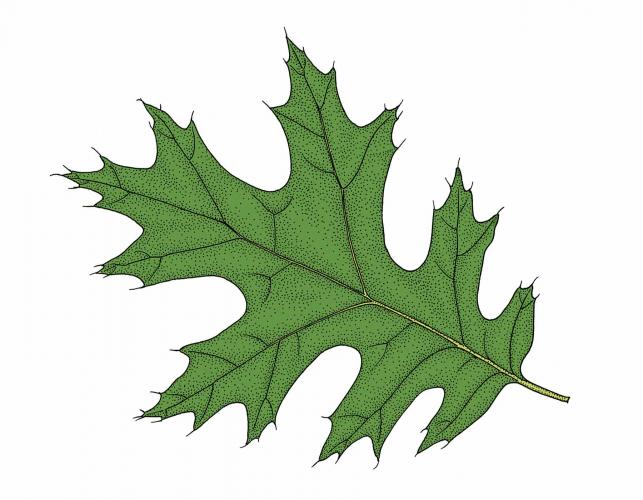
Scarlet oak is a medium-sized tree with a long, straight trunk, an open, narrow crown, and sometimes persistent dead branches on the lower trunk.
Leaves are alternate, simple, 3–7 inches long, with 7–9 lobes extending more than halfway to the central vein, the notches rounded and C-shaped, the lobe tips with large, bristle-tipped teeth. The upper surface is bright green, shiny, and smooth; the lower surface is paler, sometimes with tufts of rusty hairs at the axis of main veins. Leaves turn scarlet in autumn.
Bark has shallow grooves and irregular ridges, becomes scaly with age.
Twigs are slender, greenish at first; orange-red or brown with age, smooth or hairy. Bud scales have whitish hairs near the tip.
Flowers April–May, in catkins.
Fruits September–October, acorns solitary or paired; nut brown, broadest near the base, ½–1 inch long, top sometimes with concentric rings; cup covering about ½ of the nut, cup scales thick, flattened, sometimes warty, shiny, smooth. Acorns ripen in autumn of the second year.

Habitat and Conservation
Human Connections
Lumber from scarlet oak makes up a large part of Missouri’s timber harvest.
This oak is also used for windbreaks.
Scarlet oak is a popular landscaping tree for its relatively fast growth, attractive form, and scarlet autumn foliage. It does better than pin oak in drier sites, but it doesn’t tolerate air pollution as well.
Ecosystem Connections
A prolific bearer of acorns, scarlet oak is an important wildlife tree.
When Missouri’s shortleaf pine forests were felled (before the 1920s), scarlet and black oak soon dominated those areas. Now that those trees are nearing the end of their lives, land managers are reintroducing the shortleaf pine.








































